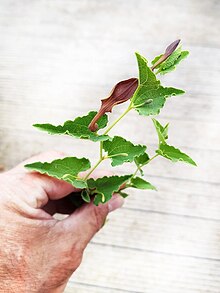
The Aristolochiaceae are a family, the birthwort family, of flowering plants with seven genera and about 400 known species belonging to the order Piperales. The type genus is Aristolochia L.

Artemisia vulgaris, the common mugwort, is a species of flowering plant in the daisy family Asteraceae. It is one of several species in the genus Artemisia commonly known as mugwort, although Artemisia vulgaris is the species most often called mugwort. It is also occasionally known as riverside wormwood, felon herb, chrysanthemum weed, wild wormwood, old Uncle Henry, sailor's tobacco, naughty man, old man, or St. John's plant. Mugworts have been used medicinally and as culinary herbs.
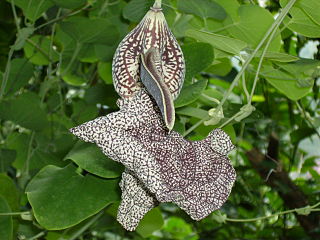
Aristolochia is a large plant genus with over 500 species that is the type genus of the family Aristolochiaceae. Its members are commonly known as birthwort, pipevine or Dutchman's pipe and are widespread and occur in the most diverse climates. Some species, like A. utriformis and A. westlandii, are threatened with extinction.

Dysphania ambrosioides, formerly Chenopodium ambrosioides, known as Jesuit's tea, Mexican-tea, payqu(paico), epazote, mastruz, or herba sanctæ Mariæ, is an annual or short-lived perennial herb native to Central America, South America, and southern Mexico.
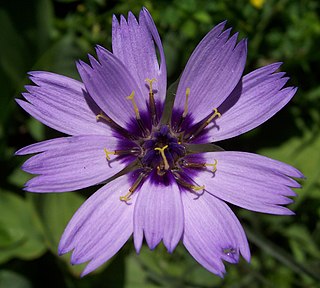
Catananche caerulea, or Cupid's dart, is a greyish green perennial herbaceous plant with a basal leaf rosette and conspicuous blue-purple or sometimes white flowerheads, belonging to the daisy family. It is a popular garden plant and is often used in dried flower arrangements.

Aristolochia californica, the California pipevine, California Dutchman's-pipe, or California snakeroot is a perennial woody vine of western North America.

Aristolochia rotunda, commonly known as smearwort or round-leaved birthwort, is a herbaceous perennial plant native to Southern Europe.

Stephania is a genus of flowering plants in the family Menispermaceae, native to eastern and southern Asia and Australia. They are herbaceous perennial vines, growing to around four metres tall, with a large tuber. The leaves are arranged spirally on the stem and are peltate, with the leaf petiole attached near the centre of the leaf. The name Stephania comes from the Greek, "a crown". This refers to the anthers being arranged in a crown-like manner.

Aristolochia gigantea, the Brazilian Dutchman's pipe or giant pelican flower, is an ornamental plant native to Brazil. Typical of subtropical Bahia and Minas Gerais vegetation, it is a vigorous evergreen climber (vine) with heart-shaped leaves and spectacular fragrant flowers. This plant is cited in Flora Brasiliensis by Carl Friedrich Philipp von Martius. A. gigantea and other tropical Dutchman's pipe varieties pose a threat to the pipevine swallowtail butterfly. The butterfly confuses A. gigantea with its native host plant and will lay eggs on it although pipevine swallowtail caterpillars cannot survive on the foliage.

Zerynthia polyxena, the southern festoon, is a butterfly belonging to the butterfly family Papilionidae.
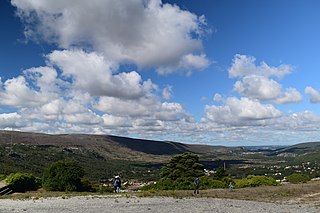
Serras de Aire e Candeeiros Natural Park (PNSAC) is a natural park in central west Portugal. It occupies an area of 383.9 km2 (148.2 sq mi) and is the most important repository of limestone formations in Portugal with a variety of geological formations associated with karst topography such as caves, sinkholes, uvalas, poljes, limestone pavements, ponors, among others. It was made a protected area in 1979 with the intend to protect the existing natural aspects and the architectonic and cultural heritage linked to the local populations.

Aristolochia longa or long aristolochia is a species of pipevine.
Aristolochia boosii is a species of woody vine in the Aristolochiaceae plant family which is endemic to Trinidad and Tobago. Known only from a few locations in southern Trinidad, the species was first collected by Julius Boos in 1977. After determining that it was new to science, the species was described by Jacqueline Anne Panter in 1981 and named for its discoverer.
Morocco provides a refuge for a rich and diverse flora with about 4,200 taxa, of which 22% are endemic. The phytogeographic zones of Morocco comprise 8 zones: the Mediterranean zone, the Cedar zone (1000-2000m), the sub-Alpine zone (2,000-2,500m), the Alpine zone (2,500m+), the semi-desert scrub zone, the Reg, the sandy desert zone and the oases.

Aristolochia praevenosa, synonym Pararistolochia praevenosa, is an Australian plant in the birthwort family, native to Queensland and New South Wales. The Richmond birdwing butterfly vine grows in subtropical rainforest in coastal areas north from Wollongbar, in far north eastern New South Wales and adjacent areas in south eastern Queensland. It has been recorded as far north as the Mary River. It also grows in tropical north eastern Queensland, where it is a food plant for the Cairns birdwing butterfly.

Millieria is a genus of moths in the family Choreutidae, containing only one species, Millieria dolosana, which is found from Morocco north to Germany, France and Poland, east to southern Russia and Israel.

Odyssea paucinervis is a species of African plants in the grass family. The genus is named after the ancient Greek tale the "Odyssey", in allusion to the long journey the type species has taken through nine genera before settling in this one. The specific name means "few veined".

Aristolochia reticulata, the Red River snakeroot, Texas Dutchman's pipe, or Texas pipevine, is a species of perennial herb in the family Aristolochiaceae, and endemic to Arkansas, Louisiana, Oklahoma, and Texas. Its habit is erect to sprawling, up to 0.4 meters in height. It flowers in summer and late spring, and summer and grows in moist, sandy soils.
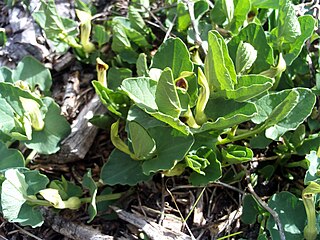
Aristolochia paucinervis is a herbaceous plant in the family Aristolochiaceae endemic to the western Mediterranean Basin.

